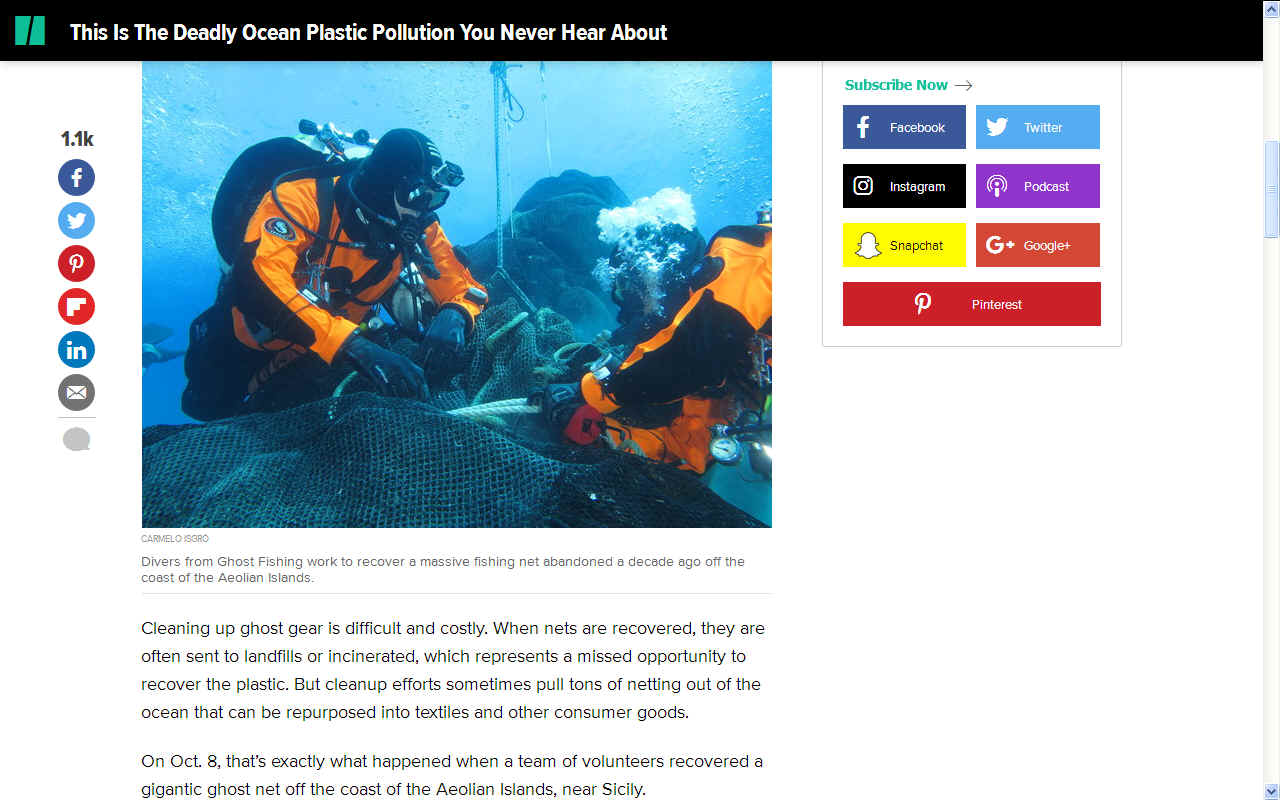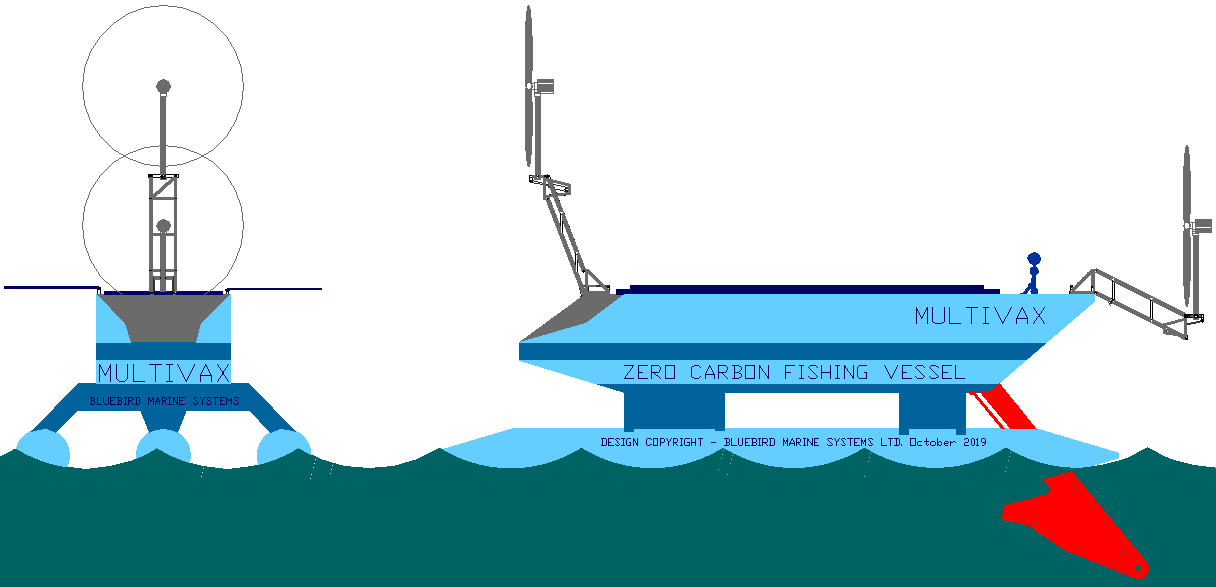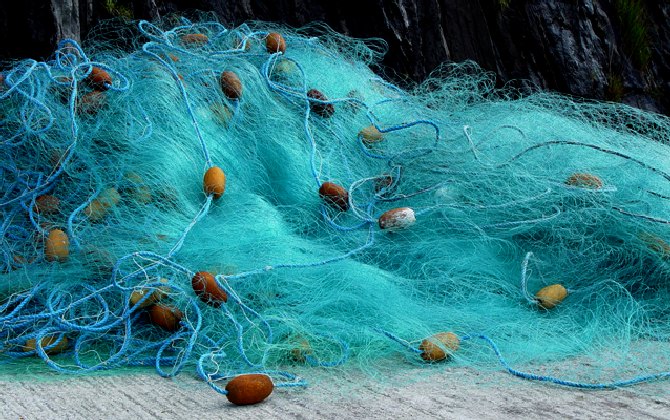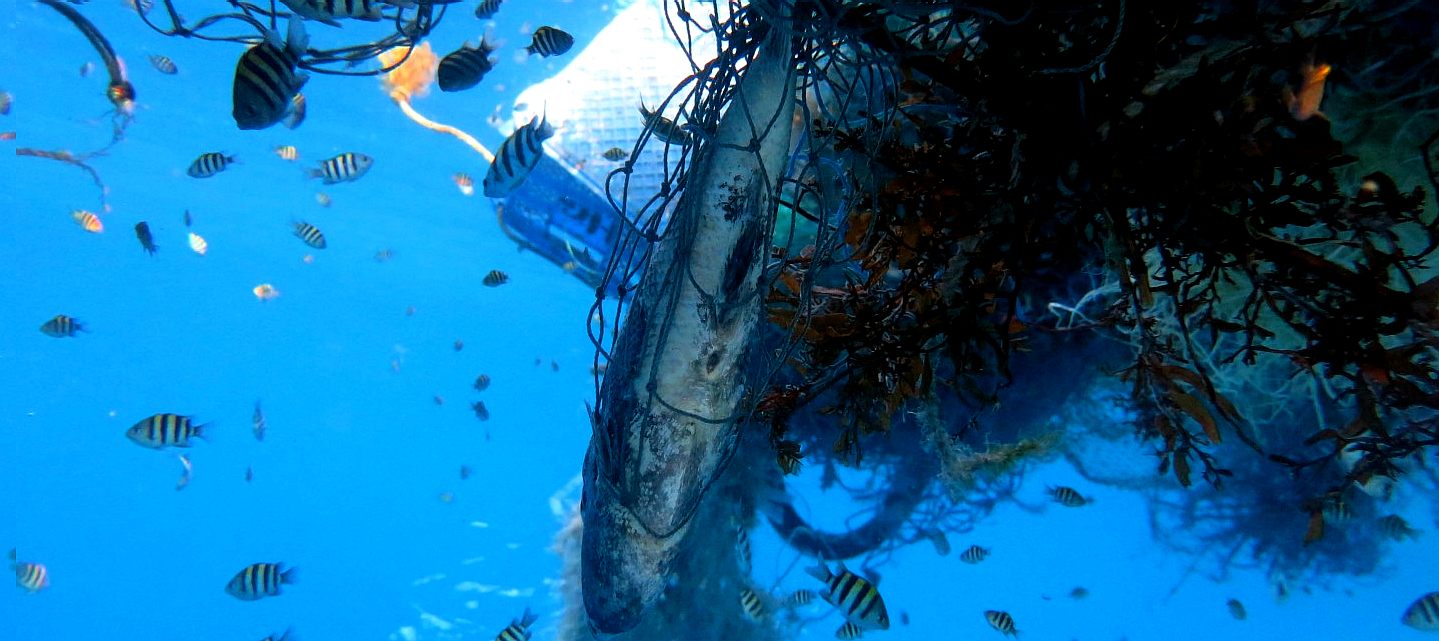|
GHOST
GEAR
ABOUT -
CONTACTS - DONATE
- FOUNDATION -
HOME - A-Z INDEX

VOLUNTEERS -
If it was not for the many brave
volunteers who work to clear such gear, more plastic would end
up being distributed around the world. The Huffington Post
appears to be covering many stories to do with ocean pollution
with well written articles that tell it like it is.
HUFFINGTON POST 24 OCTOBER 2018 DEADLY OCEAN PLASTIC POLLUTION
While cities and businesses across the country move to cut down on
ocean pollution by banning plastic
straws, there’s an even bigger plastic crisis devastating marine ecosystems ― and most of us aren’t aware of it.
Each year, millions of tons of plastics end up in the oceans. Drinking straws are thought to make up less than 1 percent of that debris. By comparison, commercial fishing fleets lose or abandon more than 700,000 tons of plastic nets, lines and traps ― an estimated 10 percent of the plastic waste in the oceans and seas.
Known as “ghost gear,” abandoned fishing items can be practically invisible in dim, underwater light, and each year they entangle and kill millions of marine animals, including sharks, dolphins, seals and turtles. The plastic these nets are made of will linger below the surface for hundreds of years, slowly degrading into small fragments and becoming part of the food chain. What’s more, there is no registry for fishing gear like nets, so ghost items can’t be traced back to the owner, allowing commercial fishers to escape accountability.
Cleaning up ghost gear is difficult and costly. When nets are recovered, they are often sent to landfills or incinerated, which represents a missed opportunity to recover the plastic. But cleanup efforts sometimes pull tons of netting out of the ocean that can be
re-purposed into textiles and other consumer goods.
On Oct. 8, that’s exactly what happened when a team of volunteers recovered a gigantic ghost net off the coast of the Aeolian Islands, near Sicily.
The mass of twisted nylon weighed nearly 3 tons and measured 650 feet long. It once made up part of an aqua-culture fish farm project that was destroyed in a storm over a decade ago. Weighed down by sand, the abandoned net sat more than 100 feet below the surface.

NO
NET FISHING - The 'MultiVax' is a concept for a fishing
boat that uses no nets. Instead, a mechanical scoop trawls
under the waves for fish, using advanced sensors and fish
finders. The fishing head is shown in red in the picture
above. It can be deployed to fish for sardines, mackerel or
herring or even krill. The head can be raised and lowered to
different depths. This vessel is also solar and wind powered,
so uses no diesel fossil fuels. Copyright ©
diagrams October 24 2019. All rights reserved, Cleaner Ocean
Foundation Ltd and Bluebird Marine Systems Ltd.
Marine animals have learned to avoid the area around the net, and frustrated local fishermen have repeatedly tried to remove it, to no avail. It was simply too great a task to cut it into pieces and haul it to shore.
Healthy Seas, a global initiative that removes plastic waste from the oceans and recycles it into textile products, thrives on this type of challenge. The organization launched three boats ― containing six divers from the Netherlands, two Italian divers and three local fishermen ― from a harbor on the island of Lipari. They had spent the previous two days recovering about 2,000 pounds of plastic fishing waste from the crystal blue waters, including scores of nylon fishing lines that were coiled like plates of spaghetti on the harbor seabed.
When the team reached the ghost net, the divers cut it free, bundled it together with rope and attached a series of lift balloons. The years of debris caught in the net made it too heavy for the boat winch to take the strain, and the three fishermen leaped into action, grabbing and hauling it into a boat. It was painstaking work, and sometimes the net looked in danger of sliding back into the water.
“The net’s not out until it’s out,” Veronika Mikos, the project coordinator, repeated as she watched them work.
After nearly an hour of grabbing and heaving, the last fold of nylon was in the boat. Divers and fishermen high-fived. The monster net, the biggest continuous net Healthy Seas has brought to the surface to date, was out of the ocean.
But the saga wasn’t over. The next phase of the plan was to clean and ship the net to a factory in Slovenia, where it will be turned into clothing. Aquafil, an Italian company, funded Healthy Seas’ expedition and plans to turn the netting into Econyl, a regenerated nylon fiber made from recycled plastic polymers.
Worldwide, there are a number of initiatives similarly removing and recycling ghost gear and other marine debris. Aquafil CEO Giulio Bonazzi said his company’s methods are different from most.
Usually, recycling plastic requires a mechanical process: chopping the plastic into small flakes and turning it into pellets that can be used to make low-grade plastic products, including flowerpots and trays for food packaging.
But Aquafil uses a chemical form of purification that takes the
fishing net back to its original form: oil. According to Aquafil, this uses 80 percent less energy than making nylon from virgin oil. And it makes high-quality, high-performance yarn that clothing brands have used in complex products like bikinis, athleisure apparel and sundresses.
Huge fishing nets can yield enough yarn to make thousands of garments.
But recovery efforts like the one Healthy Seas pulled off last week aren’t always feasible. Demand is high for fishing gear made from cheap, mixed-plastic
polymers, which are difficult to recycle.
“There are two things that need to change,” Bonazzi said.
First, he said, “nets must only be made from plastic polymers that we know we can recycle into something useful and desirable. We must keep it simple.”
And, second, nets should not become ocean waste to begin with.
“There needs to be a global registry of fishing gear. When the fishing communities buy their nets, it is logged and registered, and at the end of the useful life of the gear, they are responsible for returning it for recycling,” he said.
“There is no reason for ghost nets,” he added. “We should be able to recycle 100 percent of nets. We have the capacity; we have the technology.”
By Lucy
Siegle

NYLON -
This is a nylon fishing net with float line attached to small plastic floats.
Nylon is a very strong and durable engineering grade plastic
that is also used to make bearings for machinery, printers and
many more applications. It is not the plastic that is at falut,
it is the way we are using it for fishing.

PROBLEM - From 2000 to 2012, the National Marine Fisheries Service reported an average of 11 large whales entangled in ghost nets every year along the US west coast. From 2002 to 2010, 870 nets were recovered in Washington (state) with over 32,000 marine animals trapped inside. Ghost gear is estimated to account for 10% of all marine litter.
According to the SeaDoc Society, each ghost net kills $20,000 worth of Dungeness crab over 10 years. The Virginia Institute of Marine Science calculated that ghost crab pots capture 1.25 million blue crabs each year in the Chesapeake Bay alone.
In May 2016, the Australian Fisheries Management Authority (AFMA) recovered 10 tonnes of abandoned nets within the Australian Exclusive Economic Zone and Torres Strait protected zone perimeters. One protected turtle was rescued.
Some commercial fisherman use gillnets that are suspended in the sea by flotation buoys, such as glass floats, along one edge. In this way they can form a vertical wall hundreds of metres long, where any fish within a certain size range can be caught. If not collected by fishermen these nets can continue to catch fish until the weight of the catch exceeds the buoyancy of the floats. The net then sinks, and the fish are devoured by bottom-dwelling crustaceans and other fish. Then the floats pull the net up again and the cycle continues. Given the high-quality synthetics that are used today, the destruction can continue for a long time.
BYCATCH
Fisheries often use large-scale nets that are indiscriminate and catch whatever comes along; sea turtle,
dolphin, or
shark. Bycatch is a large contributor to sea turtle deaths. Longline, trawl, and gillnet fishing are three types of
fishing with the most sea turtle accidents. Deaths occur often because of drowning, where the
sea turtle was ensnared and could not come up for
air.

GHOST
NETS - A sea
turtle is ensnared in this fishing net that has been abandoned
by fishermen. Fishing nets are made
of plastic that is very tough and float around killing marine
wildlife and when they finally sink, cause more harm to ocean
ecosystems. Ghost nets are fishing nets that have been left or lost in the ocean by fishermen. These nets, often nearly invisible in the dim light, can be left tangled on a rocky reef or drifting in the open sea. They can entangle fish, dolphins, sea turtles, sharks, dugongs, crocodiles, seabirds, crabs, and other creatures, including the occasional human diver. Acting as designed, the nets restrict movement, causing starvation, laceration and infection, and suffocation in those that need to return to the surface to breathe.
LINKS
& REFERENCE
https://www.huffingtonpost.co.uk/entry/single-use-plastics-are-going-to-be-banned-across-the-eu_uk_5bd1838fe4b0a8f17ef45ae9
https://www.huffingtonpost.co.uk/entry/ocean-plastic-fishing-waste_us_5bc47dc9e4b0bd9ed55c1f60
ABS
- BIOMAGNIFICATION
- BP DEEPWATER - CANCER
- CARRIER BAGS
- CLOTHING - COTTON BUDS - DDT - FISHING
NETS
FUKUSHIMA - HEAVY
METALS - MARINE LITTER
- MICROBEADS
- MICRO
PLASTICS - NYLON - OCEAN GYRES
- OCEAN WASTE
PACKAGING - PCBS
-
PET - PLASTIC
- PLASTICS
- POLYCARBONATE
- POLYSTYRENE
- POLYPROPYLENE - POLYTHENE - POPS
PVC - SHOES
- SINGLE USE
- SOUP - STRAWS - WATER
This
website is provided on a free basis as a public information
service. copyright © Cleaner
Oceans Foundation Ltd (COFL) (Company No: 4674774)
2018. Solar
Studios, BN271RF, United Kingdom.
COFL
is a charity without share capital.
|



